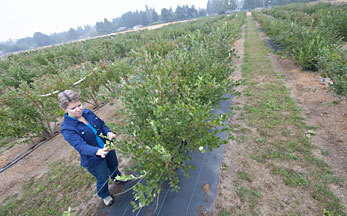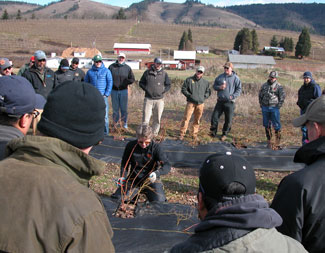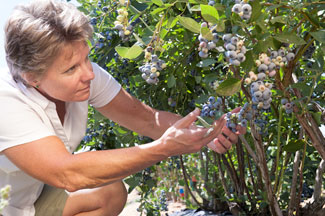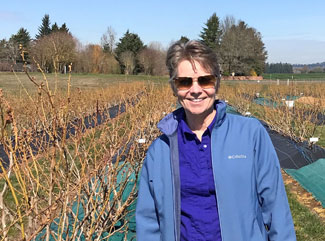A Legacy Like No Other in Blueberries
In the fall of 1987, when Bernadine Strik started working as Extension Berry Specialist for Oregon State University, the industry standard in blueberries was to plant bushes four feet apart in the row. Nobody to her knowledge was using trellises and growers either mulched in the row with sawdust or had bare ground.
 |
Bernadine Strik examining a blueberry trial in 2002. |
Today, largely resulting from Strik’s research, blueberries are grown two-and-a-half to three feet apart with the aid of trellises and weed mat mulch is common. Yields during development years have increased dramatically, in part because of changes in planting density, pruning and fertility practices Strik brought to the industry, and organic production has increased from less than two percent to more than 20 percent of Oregon acreage.
Strik, who will retire later this year, came into blueberries with what she refers to as “fresh eyes” at a time when the Oregon industry was in its infancy (Oregon was home to just 1,200 acres of blueberries in 1987, compared with 15,000 acres today).
“I knew less about blueberries than many of the other crops I worked with at the time,” Strik said. She questioned every aspect of the production systems.
One of her first questions for blueberry growers was why they planted the bushes four feet apart. Growers said they did so because when plants reached maturity, in eight or nine years, they were big and bushy and required the spacing.
“So, I said, ‘Well, if you plant them closer in the row, then the bushes won’t get as big and maybe you will get to maximum yield sooner,” Strik said.
Growers responded that they believed they would need to take out every other plant at maturity if they planted to the denser spacing.
“So, I said, ‘Okay, how about I do a research study on that,’” Strik said.
The multi-year project unveiled some startling results. Strik found that when plants were planted three feet apart in the row, yield was 50 percent higher during the establishment years. And once mature, yield was the same.
“So, there was no disadvantage once they were mature, and we didn’t need to take out every other plant,” Strik said.
By the time the study was at its halfway point, growers already were adopting the closer spacing.
“The industry was looking at (the research trial) every year at (the annual blueberry) field day, and boy was that quickly adopted,” Strik said. “Now, the most common spacing, not just in Oregon but in every region northern highbush are grown, is two-and-a-half to three feet apart.”
As part of that same experiment, Strik started studying trellising blueberries, a practice not being done at the time.
“I knew that machine harvest would become more popular,” Strik said, “so in that same trial, I was looking at whether a trellis helped. If we could just keep the bush more upright, with a simple T-bar with two wires, we could improve harvest efficiency.”
 |
Bernadine Strik in an organic blueberry field in 2012. |
Without trellising, Strik measured that an average of 20 to 24 percent of total yield was lost on the ground during machine picking. “But when we trellised, we were able to improve machine-harvested yield by four to eight points. That is a huge amount,” she said. “If you look at the total yield of a mature blueberry field, at 20,000 pounds, if you can recover an additional five percent even, that is a huge amount of money. We paid for the trellis in one year, and the trellises last for a long time.”
Like the denser spacing, the use of trellises also was quickly adopted by the industry. “Even hand-picked growers adopted the trellis,” Strik said. “And not just in our region, but in California because the fruit doesn’t bend over as much, which helps in hand picking.”
Strik’s research also has resulted in the industry today leaving about 30 flower buds per plant in the second year after planting to capture some yields. Prior to her research, the industry pruned off all fruit buds in year two and waited until the third year to capture some yield. That too, has helped increase revenue for growers during the development years.
Organic Mulches
In 2006, Strik started a long-term project comparing sawdust and other organic mulches to weed mat as part of a long-term organic blueberry trial. Growers at the time favored sawdust, because, as she said, it was cheap and effective at helping control weeds. At the time, she said, less than 10 percent of the plantings in Oregon had weed mat. Today, almost all new plantings are established with weed mat and 70 to 90 percent of existing fields now include weed mat.
“What we found is that in some cultivars, weed mat increased yield up to 10 percent, even when weeds were controlled in the mulches,” she said. “So, it wasn’t because of the weeds, it was simply because of the change the weed mat did to soil temperature.”
Growers were still concerned about the cost, however, but, here again, the research showed that incorporating weed mat into production systems more than paid for itself in a short window of time.
“We found that weed mat reduced weed management costs compared to sawdust by 75 percent for organic growers, and led to two fewer herbicide sprays for conventional growers per year, so it quickly paid for itself,” she said.
One caveat to this research is that Strik found that after 11 years under weed mat, organic matter in the soil was decreased to a point that it was lowering yields. Research has since shown that adding sawdust under the weed mat alleviated issues with soil temperature and actually increased yield.
“We were able to show that when you put weed mat over sawdust in the row, we were able to increase yield 30 percent over weed mat over bare soil,” Strik said. “So that showed two key things. One is that if growers currently have sawdust, there is no disadvantage to putting weed mat over that existing mulch, as long as you irrigate underneath the weed mat, and there is a potential to increase yield. And secondly, it illustrated that growers who are currently using weed mat on bare soil need to seriously think about adding a layer of sawdust underneath it before the soil organic matter drops too low.”
When Strik started in on the organic blueberry trial, organic production was almost nil in Oregon. But growers were interested.
 |
Bernadine Strik teaching a pruning workshop in Hood River in 2014. |
“They approached me and said, ‘You know, there is a real market for organic blueberries, and we want to know how to best grow blueberries organically. Can we just use the substitution method, use the exact production system, take an organic fertilizer and substitute it for the conventional one?’”
The growers also were wondering if it was possible to economically control weeds, diseases and insects. And, they were wondering about the yield potential of blueberries in organic systems.
“They had no idea of their maximum potential yield,” Strik said. “So, they asked me to lead that research, which I considered an honor.”
First off, Strik’s research showed that yields were dramatically improved if the plants were grown on raised beds versus on flat ground. “So, with that higher yield, I very quickly said, ‘I wouldn’t plant on flat ground if I were establishing any blueberries, conventional or organic,’” she said.
The research also showed that organic growers should choose weed mat over sawdust or compost mulches, “because your weed control costs are exorbitant if you don’t use weed mat,” she said.
She also found that some cultivars are trickier than others to grow organically. And the study helped refine fertility recommendations, a finding that had ramifications across conventional production, as well as organic. The fertility experiment showed that growers could cut in half the amount of fish fertilizer that was being applied at the time and actually increase yield on the Duke variety.
“Think about the cost of organic fertilizers,” Strik said. “The growers that adopted this came to me the following year and said, ‘I have more yield now and I’ve saved $900 an acre a year in fertilizer costs.’”
What the research uncovered is that with fish fertilizer, growers not only were adding nitrogen, they were adding potassium to soils that were already flush with potassium. Strik spent the next four years fertigating the trial with a soybean-based liquid fertilizer that was devoid of potassium and the results were striking. “It took two years, but in 2019 and 2020, we saw yields that were 50 percent higher than in 2016,” Strik said.
Even after four years, in 2020, there was still a sufficient amount of residual potassium in the soil to generate high yields, Strik said.
The research trial also showed a huge potential for yields in organic production.
“What boggled my mind is that in 2016, our best treatments were already yielding what commercial fields were yielding,” Strik said. “And then we were able to improve the yields.”
Strik’s research on best fertilization practices have included best timing of application and rates for nitrogen fertilizer. She was able to show that optimizing timing of nitrogen and lowering rates either improved or maintained yield in organic and conventional production, a finding that saved growers money.
A Practical Focus
One thing Strik has always kept in mind in her research projects is the economics of adopting some of the practices she has analyzed. It is a concern that she said dates back to having grown up on a farm in British Columbia. (Strik was born in Holland and raised in Australia and Canada.)
“When you share these findings with growers, to me, the cost-benefit is very important and that has been kind of a signature of the research I’ve led, is to include economic analysis,” she said. “And I’ve always been really interested and enthusiastic in sharing our findings and the findings of others in field days, workshops, publications and the online Blueberry Course, which has been very popular.”
 |
Bernadine Strik surveying organic blueberries in 2013. |
Strik’s position as Professor in the Department of Horticulture has changed some over the years, but for the most part, she has served as Extension Specialist, Berry Research Leader at the North Willamette Research and Extension Center and has led undergraduate and graduate teaching in all berry crops.
Strik said she has been very fortunate to work with an excellent team of Faculty Research Assistants (currently Amanda Davis and Pat Jones), undergraduate and graduate students and colleagues over the years. “And I’ve always appreciated the wonderful support from growers and the Blueberry Commission,” she said.
In February last year, Strik was diagnosed with ovarian cancer, and she has been under treatment since. To date, she said, the diagnosis is good. “Needless to say, it is a scary disease,” she said, “but so far, so good. I’ve always been an optimistic person, and I continue to be so – I see no reason, based on how treatment is going so far, not to be. It helps that I feel great.”
Strik, 58, said the cancer is in no way accelerating her retirement.
“For the last five years I’ve been open about projecting this planned retirement date,” she said. When she retires December 31, it is safe to say she will leave behind a legacy unmatched by any other researcher in blueberries.
Dave Brazelton, executive chairman of Fall Creek Nursery, who has worked with Strik for more than 30 years, spoke highly of Strik’s ability to identify research topics of importance to the industry and to share her findings. “Bernadine has always had a unique ability to connect with growers, to listen and observe, identifying the issues that really matter in their production processes,” Brazelton said. “Once identified, she consistently designed research studies that got to the heart of those questions or challenges and applied strong scientific discipline to the study.
“The rigor was always excellent,” Brazelton said. “You trusted and valued the results. They confirmed or changed grower practices.
“Bernadine also had a tremendous way of milking every ounce of information from a study,” Brazelton said. “And her presentation skills are exceptional. There was always a great balance of data, images, highlights and forward-thinking questions.
“Those great qualities and so many more put Oregon blueberries on the map globally as one of the true innovation centers for the crop,” he said.
“What has made Bernadine unique, is that she has had her finger on the pulse of our industry,” said Jeff Malensky of Oregon Berry Packing. “And she carriers a unique ability to wear many hats, that of a researcher, project manager, farmer and presenter. If there is a need for information, she figures out how best to research that information, put it into a study and then break it down in her presentations.
“To me, Bernadine has been one of a kind and we are going to be at a loss,” Malensky said. “She has been such an important partner in our blueberry community. Thank you, Bernadine.”
 |
Bernadine Strik doing a workshop via Zoom in 2020. |
During her career, Strik has gained as much or more recognition from researchers as from the growers she has helped. She just recently learned she will be bestowed with the International Society for Horticulture Science’s highest honor, its ISHS Fellow Award, at its meeting next year. The award is based on a scientist’s impact to global horticulture. In 2007, she was awarded the American Society for Horticultural Science’s Fellow Award. And, in 2015, the Society also awarded her its Outstanding Graduate Educator Award.
“That is one of my favorite awards,” she said, “because it relates to the students who I’ve trained and the quality of mentorship.”
Strik also has been awarded the OSU Alumni Association’s Distinguished Professor Award.
When she leaves, Strik said she will leave without regrets. “I don’t want to be one of these people who retire and hasn’t done much in the last several years. That would be mortifying to me,” she said. “And I don’t want to be one of those professors who retires and says, ‘I wish I had done this,’ or ‘I wish I had published this.’ So, I have been working at full speed for a long time, and it is time for me to take a breather and enjoy even more special times with my husband, Neil, and our daughters, Shannon and Nicole.”
She will also leave behind a robust research and Extension program that will be ready to answer grower questions and meet industry needs well into the future.
“I leave with the comfort that my replacements will inherit some incredible faculty research assistants, some established research plantings and really strong industry support,” she said. “And that is a great feeling to have.”